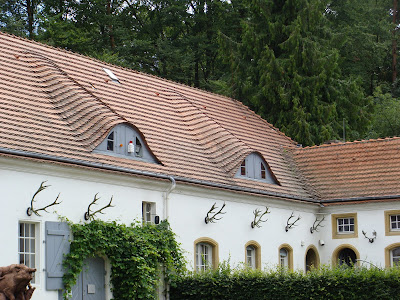 |
| 3 Fonteinen Straffe Winter at Moeder Lambic |
There are two Moeder Lambic bars in Brussels, we went to Moeder Lambic Fontainas because it was closer to where we were when we wanted a beer. It is an awesome bar. They have 30 beers on tap, mostly locally made with some guest beers from breweries like Schneider and Mikkeller. We sat down to some snacks and a good selection of beers for a couple of hours. Finally we decided to have something special from the bottle list; a 3 Fonteinen Straffe Winter, which is a Gueuze made with dark candy sugar to raise the alcohol level a bit.
The waitress corked and poured the bottle for us expertly using the little woven cane Gueze holder pictured above. It was an awesome beer, with all the characteristics of Oude Gueuze that I love, along with a bit of an alcohol hit. Britt expertly described it as 'an old log decomposing deep in the forest with moss on it'.
The next day we went to Brasserie Cantillon, which is just a little way from downtown Brussels. They make some of my favourite sour beers and I was really looking forward to visiting.
 |
| Brasserie Cantillon from the street |
It's quite a bit smaller than I expected. We were given an English pamphlet and allowed to wander all over the brewery, from the brewing room, to the coolship room in the roof where the wort is inoculated with local yeast and bacteria, and also to the barrel room and bottle storage areas.
 |
| Barrel room at Brasserie Cantillon |
After the wort cools down overnight and is inoculated by the yeast and bacteria present in the cooling room and also coming in through the vents in the ceiling, it is transferred in to clean barrels for fermentation and ageing. It then ferments furiously for a few days with the barrel unbunged. The beer will then sit in the barrel room for up to three years to develop all the complex flavours that make Lambic and Gueuze so appealing.
 |
| Cobwebs are worshipped at Cantillon |
Because of the open nature of the inoculation and fermentation of the beer at Cantillon, it is particularly sensitive to contamination by insects and the germs they carry. This is the main reason that there are loads of cobwebs all through the rafters of the cooling room and the barrel storage room. Spiders are left to take care of any fruity flies or other nasty insects, rather than use any insecticides.
 |
| Stitchybritt with a Cantillon Gueuze |
At the end of the tour everyone gets two samples of Cantillon beer. We both tried the Gueuze, and then I had the Kriek while Britt had the Rose de Gambrinus (Lambic aged with raspberries). Yum!
For dinner one night we decided to check out Restobières on good recommendation from @drsordersbrewin. It's a restaurant that specialises in dishes cooked with beer, and also has a very extensive beer menu. This place is hilarious! Unfortunately we didn't get any photos of the owner, Alain, but he was very entertaining. He kept coming out into the restaurant with different hats and fake beards to entertain his guests.
 |
| A very dusty 3yo bottle of Orval at Restobières |
We highly recommend this place to anyone visiting Brussels looking for a good meal, great beer selection and a generally entertaining night out.
 |
| Stitchybritt enjoying some Moules at Restobières |
On our last morning in Brussels we walked down to the Grand Place to check out the Belgian Brewers Museum. When we turned up half an hour after opening time, we found a securely closed big wooden door and some buzzer buttons next to it. We pressed the button labelled 'Musée', and were told to wait just a few minutes for the museum to open. After a short wait the door opened and we ventured down into the basement of the Brewer's House, the guild house of brewers in Belgium.
The museum is pretty small; one room dedicated to an 18th century brewery and another with some equipment from a modern brewery. The third room was a tasting room with two taps that rotate daily. The barman couldn't tell us which beers we were tasting however, as they are not allowed to advertise one brewery over another in the guild building.
 |
| Me enjoying a dark abbey style ale in the Brewer's Museum |
It was a nice way to spend an hour or so, and is definitely a nice place to sit with a beer after walking around town. Cheers!





















































